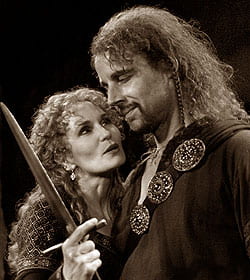This week in PLP we continued our learning on Macbeth with reading act 2 and 3, and our learning of the 1950’s, mainly focussing on social change of the time. Learning about the 1950’s societal changes was very interesting and explained a lot about what we learned in week one with the cold war. This week when thinking about the driving question “Using Shakespeare’s “Macbeth” and the history of the 1950’s, how can we use film to explore the theme of appearance vs. reality, and comment on what’s changed and what’s stayed the same?” I had different realizations when it came to comparing the differences and similarities between Macbeth and the 1950’s. Two things really jumped out at me while learning about these things, one being the treatment towards, and the role of women, and two being the ability that entertainment has to paint history differently than how it really happened.
When reading Macbeth it really became apparent to me the role that Lady Macbeth had in the story, over Macbeth, and over many other characters in the story as it went on. On the surface from the others’ point of view, Lady Macbeth is a helpless lady who’s just there to hold her place but in reality she’s the one behind the murder and the one who sets up the story, although she has to act through the man, Macbeth. This is very similar to the role of the woman in a 50’s suburban family. In the 50’s the wives were looked over as they were really just there to serve the husband and to have the kids, but really she kept everything afloat. Of course the man of the family was really important too, but without the woman it really couldn’t happen. When noticing this similarity I thought it was really odd how alike the roles of women were for so many centuries, then suddenly within the last few decades from now, such strides have been made for equality and a more healthy balance of power between the two genders.
The second thing that I noticed while learning this week was how powerful entertainment and pop culture can be with painting history in the way that it’ll be remembered in the future. In the play Macbeth, Duncan is shown as a good king and Macbeth as a horrible guy that killed him only to satisfy his ambition but in reality this isn’t really the case. The play was based off of real historical events, and King Duncan wasn’t actually a very good king and nobody was really upset about Macbeth killing him and taking over the job. Over time, people for the most part have forgotten about how King Duncan and Macbeth really were as people, and have accepted their characters in the play as the reality of who they were.
The pictures above are portraits of the real King Duncan and Macbeth.
This is very similar to how the introduction of the TV and the propagation of “The American Dream” defined the 50’s and painted it differently than it should’ve been. Many bad things were happening in the United States and around the world while suburbia was spreading and starting to thrive, but that time (at least when I think of it) it’s all wise and working fathers, subservient housewives, 2 1/2 kids, a dog, and a white picket fence. This completely makes sense too, in 1948 there were only 17,800 TV’s in the whole world, whereas in 1955 (7 years later) half of U.S. homes had one, and guess what was on TV, the American dream of course!
Both Macbeth and the 1950’s are good examples of the roles of women through history, and the power of entertainment to narrate history differently than it really happened.



Your blog is visually appealing, I really like the portraits of Macbeth, and King Duncan. The connection you’ve made between the women’s roles is really strong. I like the way you’ve highlighted the appearance versus reality within both of these eras, using vocabulary that applies to both women (Lady Macbeth, and the 50’s housewife) to connect them. Very well done post overall, your connections are very strong, and your artifact is very clean, and connect well to the paragraphs they are surrounded by.